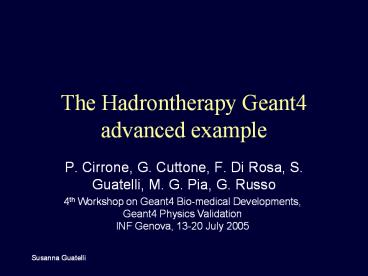The Hadrontherapy Geant4 advanced example - PowerPoint PPT Presentation
Title:
The Hadrontherapy Geant4 advanced example
Description:
The Hadrontherapy Geant4 advanced example ... it between different runs ... The total number of hadronic interactions of primary protons in the phantom as ... – PowerPoint PPT presentation
Number of Views:105
Avg rating:3.0/5.0
Title: The Hadrontherapy Geant4 advanced example
1
The Hadrontherapy Geant4 advanced example
- P. Cirrone, G. Cuttone, F. Di Rosa, S. Guatelli,
M. G. Pia, G. Russo
4th Workshop on Geant4 Bio-medical Developments,
Geant4 Physics ValidationINF Genova, 13-20 July
2005
2
Scope of the hadrontherapy Geant4 application
- Model a hadrontherapy beam line,
- Donated by CATANA
- Based on the CATANA beam line at INFN LNS
- Calculate the energy deposit in a phantom
- Dosimetry study
3
Software process
- The development of the hadrontherapy Geant4
application follows an iterative-incremental
approach - Software process products
- User Requirements document
- Design
- Documentation about the implementation is
regularly updated
4
The Hadrontherapy advanced example
- Documentation of the example www.ge.infn.it/geant
4/examples/index.html - Code review of the example in occasion of the
last Geant4 public release (7.1) - Other changes functionality added
5
Design
Primary particle
Detector
Physics List
Analysis
6
Simulation components
- Primary particles
- Physics List
- Detector Construction
- Energy deposit
- Stepping action
- Analysis
7
Primary particles
- The primary particles are protons generated with
initial energy, position and direction described
by Gaussian distributions
Particle type Proton
Position
Direction
Energy
- The primary particle component is provided of a
messenger - It is possible to change these parameters
interactively
Mean position (x -3428.59 mm, y 0., y 0.)
Sigma position (0., 1. mm, 1. mm)
Mean direction (1., 0., 0.)
Sigma position (0., 0.0001, 0.0001)
Mean energy 63.45 MeV
Sigma energy 400 keV
8
Physics component
- The user can choose
- to activate EM physics only
- to add on top the hadronic physics
- to activate alternative models for both EM and
hadronic physics
Modularised physics component
Particles p, d, t, a, ions, e-, e, pions,
neutrons, muons
9
EM Physics models
- The user can choose to activate for protons the
following alternative models - Low Energy - ICRU 49,
- Low Energy - Ziegler77,
- Low Energy - Ziegler85,
- Low Energy Ziegler 2000,
- Standard
- The user can choose for d, t, a, ions the
alternative models - Low Energy ICRU,
- Standard
- In the case of Low Energy Physics, also the
nuclear stopping power is active
10
EM Physics models
- The user can choose to activate for e-
- LowEnergy EEDL,
- LowEnergy Penelope,
- Standard
- The user can choose to activate for e
- LowEnergy Penelope,
- Standard
- The user can choose to activate for gamma
- LowEnergy EPDL,
- LowEnergy Penelope,
- Standard
11
Hadronic physics
- Elastic scattering
- Inelastic scattering
- Alternative approaches for p, n, pions
- LEP ( E lt 100 MeV) and Binary Ion model ( E gt 80
MeV) for d, t, a - Neutron fission and capture
12
Hadronic physics list
- The user can select alternative hadronic physics
lists for protons, pions and neutrons - Precompound model
- Binary model Precompound model ( with all the
option showed above ) - Bertini model
- LEP
default evaporation GEM evaporation
default evaporation Fermi Break-up GEM
evaporation Fermi Break-up
13
Detector Construction
- Detailed description of the hadrontherapy beam
line in terms of geometrical components and
materials
The user can change geometrical parameters of the
beam line through interactive commands
- The modulator is modeled
- The user can rotate it between different runs
14
Calculation of the energy deposit
- The energy deposit is calculated inside a water
phantom (size 20 mm) set in front of the
hadrontherapy beam line - The phantom is gridded in 80 x 80 x 80 voxels
along x, y, z axis - The energy deposit of both primary and secondary
particles is collected in the voxels
15
Parameters
- Threshold of production of secondary particles
10 mm - Cut per region fixed in the sensitive detector
0.001 mm for all the particles involved - More accurate calculation of the energy deposit
- Max step fixed for all the particles in the
sensitive detector 0.02 cm
16
Result of the simulation
- Energy deposit in the phantom
- Bragg Peak along the axis parallel to the beam
line (x axis) - Energy deposit of
- secondary protons
- Electrons
- Gamma
- Neutrons
- Alpha
- He3
- Tritium
- Deuterium
- along the x axis
Proton beam
x
17
Stepping action
- The user can retrieve useful information at the
level of the stepping action - The total number of hadronic interactions of
primary protons in the phantom as respect to the
electromagnetic ones - Which and how many secondary ions are produced
in the phantom - The energy distribution of the secondary
particles produced in the phantom is retrieved
18
Analysis
- Analysis tools AIDA 3.2 and PI 1.3.3
- The output of the simulation is a .hbk file with
ntuples and histograms containing the results of
the simulation - Energy deposit in the phantom
- Energy deposit of secondary particles in the
phantom - Energy distributions of secondary particles
originated in the phantom
19
Future developments of the Geant4 hadrontherapy
advanced example
- Design iteration
- How to model more efficiently the geometry of the
beam line - Code review
20
Comments
- The project of the hadrontherapy Geant4
simulation is important for - Precise dosimetry for hadrontherapy
- Geant4 Physics validation
- Comparison of the CATANA Bragg peak experimental
measurements with simulation results - Validation of alternative Geant4 e.m. and
hadronic physics models - Talk on Monday































